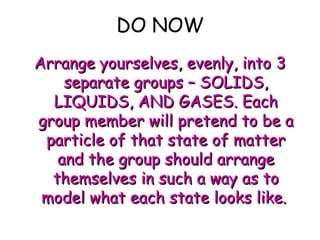
Understanding States of Matter Through Kinetic Theory
- 1. DO NOW Arrange yourselves, evenly, into 3Arrange yourselves, evenly, into 3 separate groups – SOLIDS,separate groups – SOLIDS, LIQUIDS, AND GASES. EachLIQUIDS, AND GASES. Each group member will pretend to be agroup member will pretend to be a particle of that state of matterparticle of that state of matter and the group should arrangeand the group should arrange themselves in such a way as tothemselves in such a way as to model what each state looks like.model what each state looks like.
- 2. States of MatterStates of Matter Solids, Liquids, and GasesSolids, Liquids, and Gases It’s all about understanding theIt’s all about understanding the relationships between the particles!relationships between the particles!
- 3. What is Matter? Matter is anything that has mass and takes up space.
- 4. Kinetic Theory • Kinetos –Kinetos – “to move”“to move” • The theory states that “all particles ofThe theory states that “all particles of matter are in constant motion.”matter are in constant motion.” • Can be applied to solids, liquids, andCan be applied to solids, liquids, and gases.gases.
- 5. Definition of a SOLID: • Has a definite shape and volume • Can change shape if altered. • Solids can be crystalline – regular repeating pattern of particles (salt, snow, desks) • Solids can be amorphous – non-regular patterns of particles (butter, silly putty, rubber, plastics, glass)
- 6. Behavior of Solid Particles • Particles exhibit strong attractions dueParticles exhibit strong attractions due to their close proximity.to their close proximity. • Particles are inParticles are in motion similar tomotion similar to wiggling in yourwiggling in your seats.seats.
- 7. Definition of a LIQUID: • Definite volume but not definite shape. • Take on the shape of the container they are in. • Liquids are often called “fluids” – substances that flow. • Liquids can be poured.
- 8. Behavior of Liquid Particles • Particles are more spread apart but still have attractions between themselves. • The more the particles are attracted, the more slowly that a liquid will pour or move (viscosity).
- 9. Definition of A GAS: • No definite shape and no definite volume. • Take on the shape of the container they are in. • Can be compressed.
- 10. Behavior of Gases • Particles are so far apart that there is little or no attraction between them. • Particles are crashing into each other; some slow down, others speed up. • These particles have the highest energy.
- 11. Let’s look at some analogies! How are billiard balls on a pool table like a gas?
- 12. How is a school of fish like a liquid?
- 13. How are people in a sold-out movie theater like a solid?
- 14. There are two other states of matter that we need to mention: • Plasma – 99% of all of the matter in the universe is made up of plasma. When matter occurs at extremely high temperatures, like those found on the sun or other stars, it exists as plasma.
- 15. 1 1 Bose-EinsteinBose-Einstein Condensate:Condensate: The stateThe state of matter that existsof matter that exists at extremely lowat extremely low temperatures like thosetemperatures like those reaching absolute zeroreaching absolute zero (-273(-27300 C, or 0 Kelvin).C, or 0 Kelvin). Particles move so slowlyParticles move so slowly that they behave as ifthat they behave as if they were just 1they were just 1 particle.particle.
- 16. What did you learn today? Go back to your originalGo back to your original groups and redo your models,groups and redo your models, this time also explaining thethis time also explaining the “WHY”.“WHY”.
- 17. DensityDensity Now that you have some understanding of theNow that you have some understanding of the states of matter and their particles, we muststates of matter and their particles, we must look at a property of matter called density.look at a property of matter called density. REMEMBER:REMEMBER: MassMass = the amount of matter (stuff) in an= the amount of matter (stuff) in an object.object. VolumeVolume = the amount of space that an object= the amount of space that an object takes up.takes up. D=D=MMassass VVolumeolume
- 18. Density = the ratio of mass to volumeDensity = the ratio of mass to volume The more closely packed the particles,The more closely packed the particles, the more dense the substance is.the more dense the substance is. A good way to remember the ratio is:A good way to remember the ratio is: D=D=